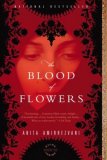Summary | Excerpt | Reading Guide | Reviews | Beyond the Book | Read-Alikes | Genres & Themes | Author Bio

Critics' Opinion:
Readers' Opinion:
First Published:
Jun 2007, 384 pages
Paperback:
May 2008, 400 pages
 Book Reviewed by:
Book Reviewed by:
BookBrowse Review Team
Buy This Book
This article relates to The Blood of Flowers
Evidence of settled communities in Iran date back to at least the 5th millennium BC (as evidenced by 7,000 year-oldwine jars that have been excavated in the Zagros Mountains).
Cyrus the Great is credited with establishing the first unified empire during his 21 year reign beginning in 550 BCE. He is also remembered for theCyrus Cylinder (discovered in the 19th century and housed in the British Museum) which some consider to be the "first charter of human rights". However, apparently it is just one example of a long tradition (dating back to the third millennium BC) in which Mesopotamian kings began their reigns with a declaration of reforms.
Shah Abbas I
Two thousand years after Cyrus the Great, Shah Abbas I, a member of the Safavid dynasty and a leading character in The Blood of Flowers, is credited with founding the modern nation state of Iran during his reign (1587–1629) which began when he was 16 years-old. Recognizing the ineffectualness of his army he sued for peace with the Ottoman empire, and then built a standing army modeled on European lines*; he also established strong trading links and centralized control.
In addition to his talents as an administrator, Shah Abbas was an ambitious urban planner and admirer of craftspeople of all types from architects to tile makers. He refashioned the city of Isfahan (photos), also known as Esfahan, which he made his capital, building many beautiful structures that still stand including the famous"Image of the World" (the great square of Isfahan).
To fund the state coffers he established centers for carpet making, selling many of the hand-loomed silk rugs to Europeans who considered them prized possessions (as can be seen in 17th century paintings of noblemen and royalty by the likes of Rembrandt and Rubens in which hand-made rugs are often shown).
At the height of Shah Abbas's reign the Persian empire comprised of modern-day Iran, Iraq, Armenia, Azerbaijan, Georgia and parts of Kurkmenistan, Uzbekistan, Afghanistan and Pakistan. Obsessively fearful of assassination he put to death or blinded members of his family who he believed to be a threat. Two sons died before him, two were blinded and one put to death. As a result, at his death there was no son capable of succeeding him.
Related Links:
Persia or Iran?
Back in the 5th century BC, the Greeks referred to the empire of Cyrus the Great as Persis, taken from the region of Fars or Pars over which Cyrus first ruled (todayFars is a province in southern Iran just south of Isfahan province).
However, the country has always been known to its people as Iran (land of the Aryans). In 1935 the Iranian government specified that the country should be called Iran, but in 1949 it allowed both names to be used. Today, most people outside of the country refer to the modern day country as Iran but many refer to the historical country as Persia, or when they are talking about products of the country (such as Persian rugs).
Iran is far from unique in having an internal and external name. For example, the country that English speakers know as Germany is Deutschland to those that live there, and Allemagne to the French.
*After the collapse of the Roman Empire it was to be about 1,000 years before Europe started to reestablish professional armies, known as standing armies. First came the Janissaries of the Ottoman Empire in the 14th century, followed by standing armies in France and England in the 15th century - during the "Hundred Years War".
Filed under Places, Cultures & Identities
![]() This "beyond the book article" relates to The Blood of Flowers. It originally ran in July 2007 and has been updated for the
May 2008 paperback edition.
Go to magazine.
This "beyond the book article" relates to The Blood of Flowers. It originally ran in July 2007 and has been updated for the
May 2008 paperback edition.
Go to magazine.





The Flower Sisters
by Michelle Collins Anderson
From the new Fannie Flagg of the Ozarks, a richly-woven story of family, forgiveness, and reinvention.

The House on Biscayne Bay
by Chanel Cleeton
As death stalks a gothic mansion in Miami, the lives of two women intertwine as the past and present collide.

The Funeral Cryer by Wenyan Lu
Debut novelist Wenyan Lu brings us this witty yet profound story about one woman's midlife reawakening in contemporary rural China.
Your guide toexceptional books
BookBrowse seeks out and recommends the best in contemporary fiction and nonfiction—books that not only engage and entertain but also deepen our understanding of ourselves and the world around us.